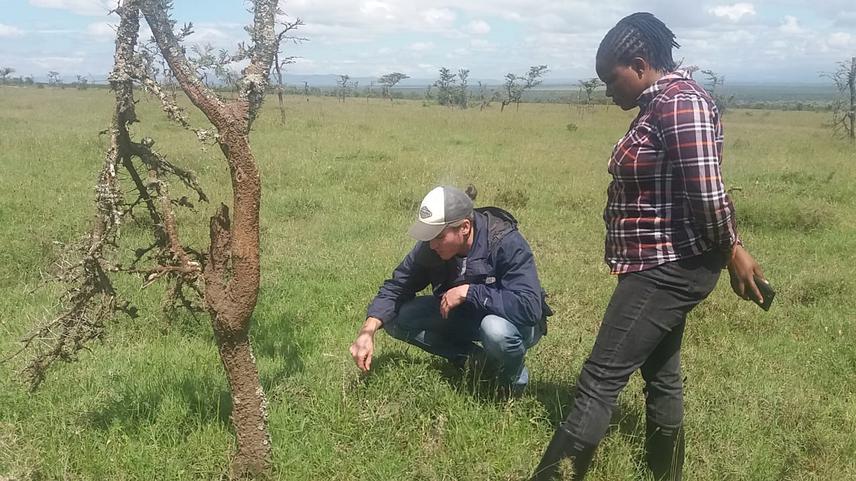Patrick Milligan
This project investigates three aspects of the big-headed ant (Pheidole megacephala) invasion in the Laikipia Plateau:
1) How does biological invasion change the native insect community?
2) Does ant invasion also affect ecological functions provided by important native insect species?
3) Can we effectively remove invasive ants using a method that was recently developed in the Western USA, and do native insects return to previously-invaded savannas?
We will investigate these questions with a 12-months-long landscape-scale experiment that will also be used to teach ecological theory and experimental/survey techniques to visiting students from Kenyan Form 4 and university classes. We will use various conventional functional ecology and entomology techniques to address questions 1 & 2, and a cutting-edge ant removal technique to conduct the first removal trial of big-headed ants in its non-native range.

PI Patrick Milligan meets with environmental impact consultant Margaret Wanjiku Kariuki, representative for the National Environmental Management Authority of Kenya.
In the last decade, big-headed ants (Pheidole megacephala) have steadily expanded into black-cotton and red-soil savanna habitats in conservancies of the Laikipia Plateau of Kenya. Typically, these invasive ants extirpate many native insect species when they move into a new habitat. In black-cotton savannas, big-headed ants have caused the wholesale extermination of Crematogaster tree-nesting ants across entire tree stands, and triggered a host of physiological problems for acacia trees that usually partner with native ants. In red-soil savannas, big-headed ants exterminate many native ant and beetle species and also protect sapsucking hemipteran insects, thus strongly changing the native insect biodiversity. Considering the large impact that big-headed ants have on insect species that play important roles in the habitat, it is imperative that we determine the consequence of invasion for ecosystem functions such as nutrient cycling, pollination, and decomposition.
To address this broad topic, we will continuously survey insects at two savanna conservancies (1 red-soil conservancy, 1 black-cotton conservancy) and monitor insect-related ecosystem functions. To inform local management practices, we will field-test the efficacy of a recently-developed and highly specific ant-removal technology, which will exterminate invasive ant queens with trace amounts of insecticide dispersed in an ant-targeting bait. In addition to the efficacy of this technology, we will monitor the return of native insects and insect-related ecosystem functions to treated savannas.
This long-term field project will establish experimental sites that will be leveraged by local university and secondary school groups to conduct independent research projects under the mentorship of the co-PIs, and to demonstrate basic concepts of invasion ecology, biodiversity, and ecosystem multi-functionality in an active-learning field setting.